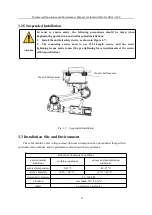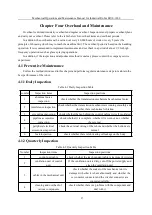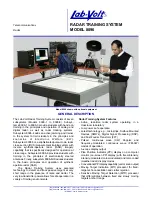
Mechanical Operations and Maintenance Manual for Industrial Robot ER10-1600
37
Chapter Five Common Faults and Treatment Measures
When the robot body fails, please refer to this chapter for initial fault diagnosis. The conditions listed
below cover the common faults that may occur on the robot body, the analysis of the fault causes, and the
corresponding handling measures, which can help users to troubleshoot common faults.
Fault
Fault classification
Possible cause of fault
Treatment measures
Vibratio
n
and
abnorm
al noise
The base and the
mounting base are
not firmly fixed
(1)
The flatness of the base
and the installation base is
not enough, or foreign matter
is included, which makes it
unable to fit tightly during
installation;
( 2 )
When connecting the
base and the installation base,
the screws are not tightened,
or the screws are loose after
long-term operation.
(1)
Check and trim the flatness of
the base and the installation base to
make the tolerance meet the
installation requirements;
( 2 )
If there is a foreign object
between the base and the installation
base, please clean it and reinstall it
firmly;
(3)
When tightening the screws, use
a torque wrench to tighten with the
required torque.
The mounting base
and the foundation
are not firmly fixed
(1)
The ground installation
conditions do not meet the
requirements, resulting in
insufficient
foundation
rigidity;
(2)
The specifications and
strength of chemical bolts do
not meet the requirements.
Refer
to
the
"3.2.3
Ground
Installation" section of this manual to
make the concrete foundation and
chemical bolt set meet the installation
requirements.
The robot vibrates
obviously in a certain
posture or state
( 1 )
The load exceeds the
allowable value, resulting in
insufficient stiffness in a
specific posture, resulting in
vibration;
( 2 )
Improper operating
procedures and parameter
settings can cause vibration.
(1)
Reduce the load and ensure it is
within the allowable range;
(2)
Modify the program and adjust
the parameters, step by step from low
speed to high speed, until the robot's
action status returns to normal.
The vibration and
abnormal noise of
the robot in the
following
three
situations:
( 1 )
After the
collision;
( 2 )
Long-term
These three conditions will
cause damage to internal
components (gears, bearings,
reducers, etc.), resulting in
vibration
and
abnormal
noise.
( 1 )
Check each axis of the
single-action robot, and consult the
after-sales service department of our
company for replacement after
confirming the damaged joint;
( 2 )
In the later operation process,
try to avoid collision and long-term
overload operation, and regularly








































